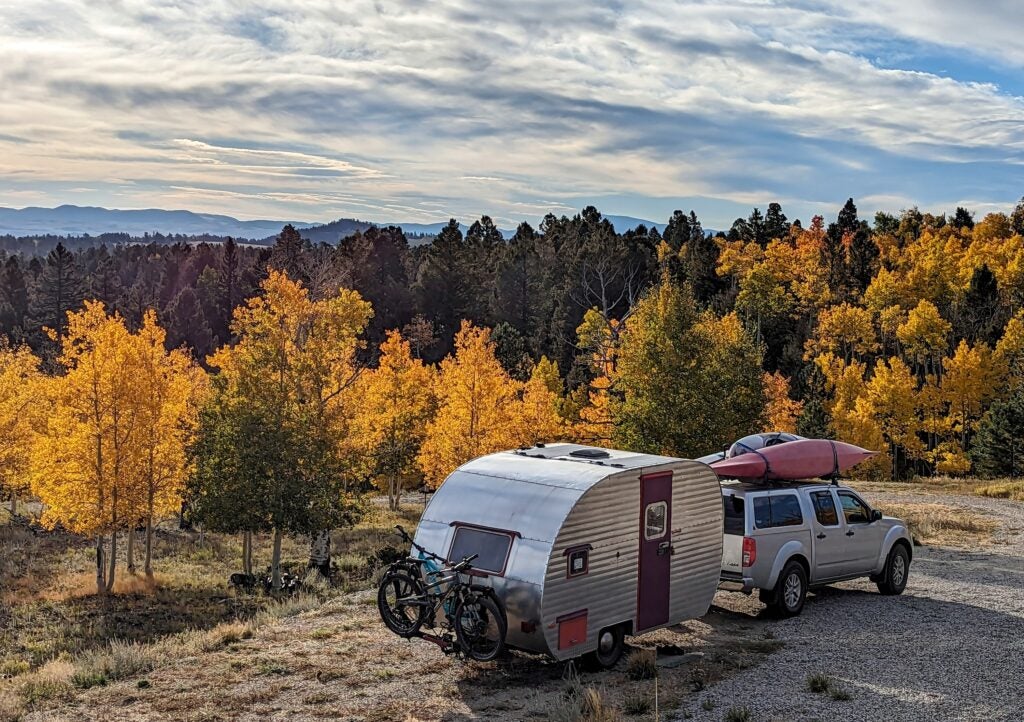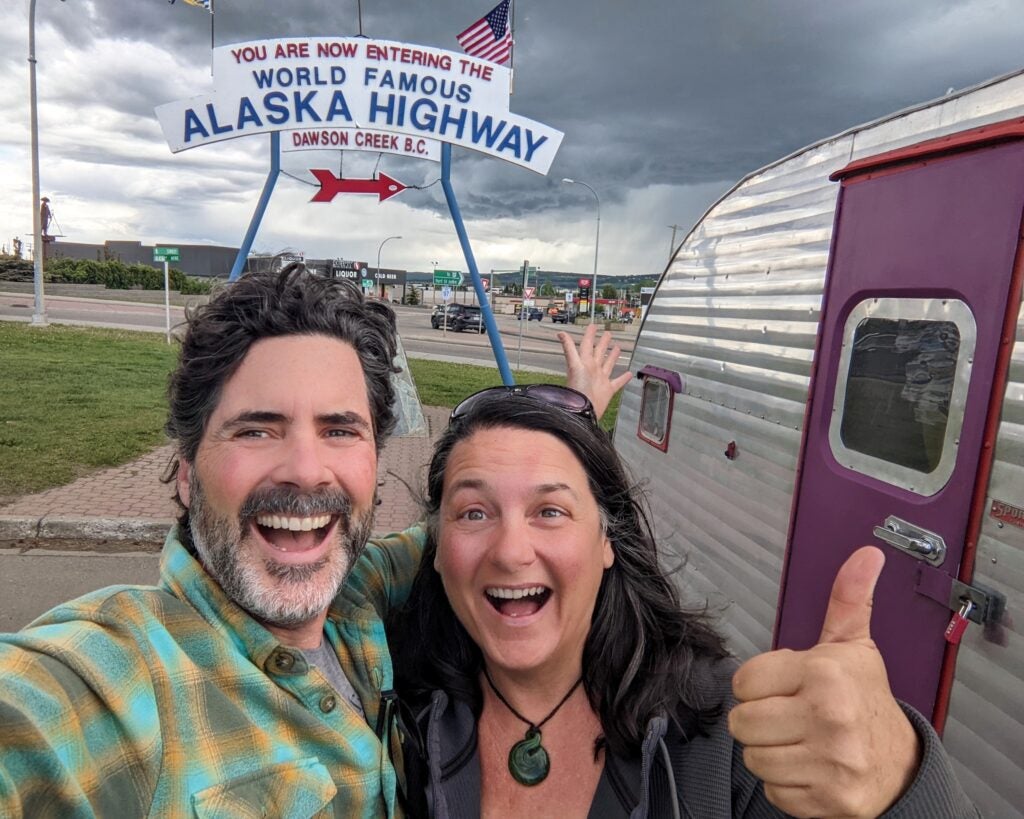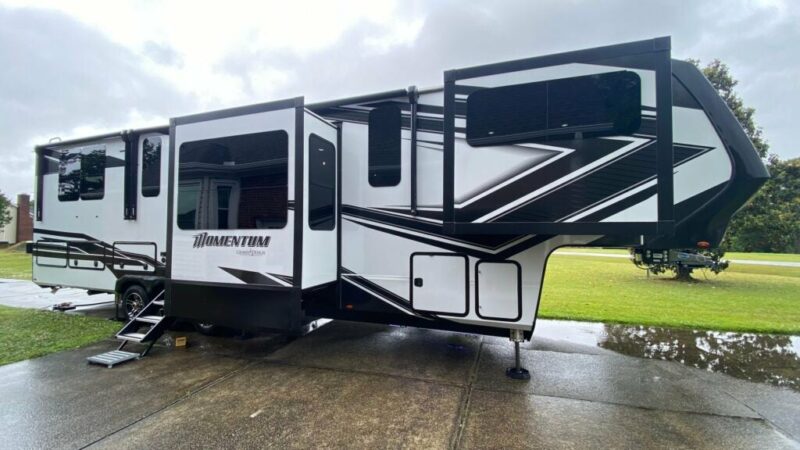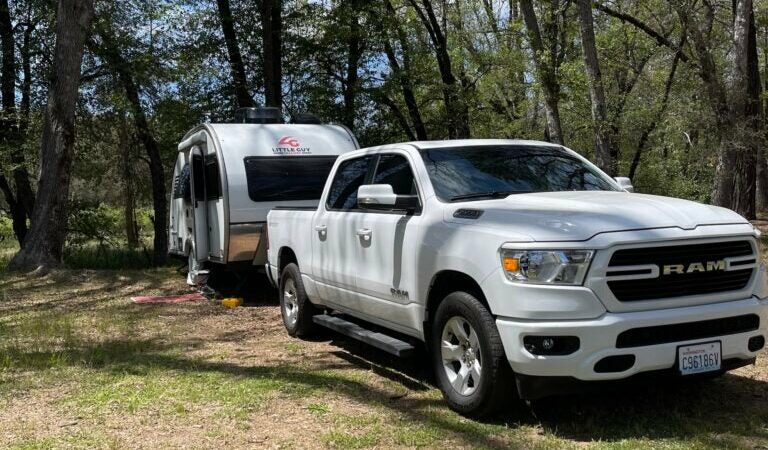This Couple Used Full-Time RV Life to Retire Early
David Hutchison and Shari Galiardi have two superpowers: they’re adaptable, and they’re extremely good with money. Those skills allowed the couple to quit their higher-education careers in their early 40s to live on the road full-time. Since then, they’ve whittled their needs down to the bare essentials, dialed in the perfect budget, and mastered the art of making money without doing anything that feels remotely soul-sucking. Now, the couple has lived in their RV for nearly 13 years and travels around the country giving talks about the lifestyle—including their financial secrets. Here are seven of their top tips.
1. Build up your savings cushion
For their first few years on the road, Hutchison and Galiardi lived almost exclusively on their savings. After all, they didn’t know it was going to turn into more than a year-long vacation. But they say the extra wiggle room those savings provided was essential for peace of mind—especially if they’d had a serious injury or a vehicle required a major repair.
“You want to have at least three to six months of expenses saved up at the minimum,” Galiardi says. “We were full-time professionals with master’s degrees, so our savings may have looked a little different. But basically, you want an emergency fund, and you want it as big as you can make it.”

The rig enjoying fall in Colorado.
2. Choose an affordable rig
The biggest expense for any RVer is their rig—which means it’s also the biggest opportunity to save a ton of money.
“A lot of people go into debt on the rig they’re driving around in,” Galiardi says. “They don’t think about all the costs associated with it—the insurance, registration, gas, or the size of the camp spots a big rig needs. All that’s going to cost more with a bigger rig, and it all adds up.”
Hutchison and Gariardi settled on a vintage camper because it was low-tech and they figured they could handle most of the repairs on their own. Over the years, the 68-year-old Sportcraft trailer has cost them no more than $5000 dollars—an order of magnitude less than the repairs on a fancier vehicle might have cost.
3. Start with a side gig.
When Hutchison and Galiardi decided to sell their house and move into an RV, they didn’t exactly know what the plan was; all they knew was that they needed a break. Maybe they’d spend a year or two on the road, then re-evaluate. But six months in, they both realized that they never wanted to go back.
“We fully committed to the lifestyle,” Galiardi says. At the time, they didn’t have enough savings to go completely jobless. For a few years, they worked seasonally, taking up summer jobs, doing product reviews, and tinkering with a blog they’d dubbed Freedom in a Can. Typically, they only worked four months out of the year. Still, the little bit of extra income meant they weren’t draining their savings right off the bat—a huge source of comfort amid a time of transition.
4. Examine your expenses
During their first year on the road, Hutchison and Galiardi meticulously experimented with their budget, seeing just how little they could live on. Volunteering on farms and in national parks helped them take advantage of free showers and campsites, reducing their costs even further.
“We like to say we weren’t shrinking our budget—we were expanding. We were testing the boundaries of what would make us happy,” Hutchison says.
Even today, the couple typically spends around $3,000 per month and no more than $36,000 per year. Because they have such low overhead, they’ve been able to put the brakes on their seasonal work and settle into a routine that looks a bit more like retirement. Most weeks, they work about half-time speaking at RV shows, working at campgrounds in exchange for free lodging, and partnering with brands on occasional freelance gigs.

Shari and Hutch on their way to Alaska
5. Stick to your values.
The decision to dial down their blogging hours was a very intentional one. Around 2019, Freedom in a Can started to gain traction. Soon after, the couple was able to quit their seasonal gigs and survive off their writing and social media income alone. Some other influencers urged them to lean in and grow the business as much as possible. But Galiardi and Hutchison had already learned that lesson.
“There’s always this pressure to do the next thing, to be as big as you can],” Hutchison says. “And we always think, ‘Well, what’s that going to get us?’” More stress, they decided—not more happiness. After all, that was the whole point of living in an RV and trimming their expenses in the first place: it gave them the freedom to say no to any work they didn’t want to do.
The best way to save money living in an RV is to keep doing it as long as you can. And if you want the lifestyle to remain sustainable, saying no to work is just as important as saying yes.
6. Go off-grid
Hutchison and Galiardi also recommend choosing a rig that can go off-grid. Having solar power and/or a Starlink can help you get away with long stints of boondocking on public land. That tends to be much cheaper than paying hefty campground fees. “Solar is the secret to our lifestyle,” Hutchison says simply.
7. Use The Dyrt to find great deals
Another essential money-saving secret: The Dyrt. The app helps RVers like Hutchison and Galiardi find free and low-cost camping on public lands around the country.
“It’s our go-to if we’re looking for a campground,” Galiardi says. “We also love The Dyrt Alerts. They’ve gotten us into some pretty cool places at the last minute. Last spring, for example, we managed to pull together a two-week vacation in Yosemite without making any reservations ahead of time.” The couple also uses the app’s public land layer to see what kinds of recreation opportunities are around and to check that any boondocking sites are legal.
“You can also reserve campsites at private campgrounds through the app,” Hutchison adds. “We rarely do that, but that’s what’s great about The Dyrt—you can use it in so many different ways.”
Between their smart savings strategy, intentional budgeting, and clever use of apps and other wallet-friendly tools, Galiardi and Hutchison have managed to turn their extended vacation into a sustainable long-term lifestyle. It’s not always easy, Hutchison says, but it’s always worth it.

Camping in the Sierras
The Dyrt is the only camping app with all of the public and private campgrounds, RV parks, and free camping locations in the United States. Download now for iOS and Android.
Popular Articles:
Articles on The Dyrt Magazine may contain links to affiliate websites. The Dyrt receives an affiliate commission for any purchases made by using such links at no additional cost to you the consumer.
Source: https://thedyrt.com/magazine/lifestyle/shari-and-hutch-rv-life/






